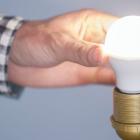Save energy while keeping an ideal room temperature
Submitted by Sandra Temmel and Agata Gerroir on | Updated Thu, 11/05/2017 - 19:57

We all like coming back to a comfortable home. The ideal room temperature, whether that's warm and cozy or cool and refreshing, depends on your preferences. Your thermostat controls half of your energy bill, costing more than your appliances, electronics and lighting combined.i So shouldn’t it help you save energy? The thing is that 40-55% of people are setting their thermostat the wrong way which means they end up paying an arm and a leg on heating.ii Are you one of them?
Finding the compromise between comfort and lower energy bills is very important. No one likes coming home to a meat locker but is it possible to have an ideal room temperature, without throwing money out the window?
The easiest thing you can do to control your heating costs is to setup your thermostat properly.
In this article, we'll show you how to easily save $79-$110 per heating season (October-March), without turning your house into a freezer.
That’s $79-$110 you can spend with friends and family. Pizza party anyone? Or just put it into a savings account for a rainy day. If you want to take these steps a bit further, you can save even more money. But it’s not just energy savings that these changes offer.
By only heating your home when it’s necessary you'll also be able to help out the environment and reduce your carbon footprint by 904 - 1152 lbs.
These changes also have some nifty health benefits: burn more calories, protect yourself from diabetes, reduce insomnia and have a deeper more relaxing sleep.
We'll show you how to do all of this without sacrificing comfort. This simple guide on using your thermostat properly will help you to maximize your savings throughout the winter, whether you have a steady day to day routine or not.
Here are the typical benefits of changing your thermostat settings:
|
Money |
Average savings per heating season (October-March) |
$79-$110 depending on if you heat with natural gas or electricity iii, iv, v |
|
Initial cost |
Free or $35-$250 for a new thermostat |
|
|
How long to get back your money |
Immediate or 2-3 winters if you buy a thermostat |
|
|
Carbon footprint |
Average CO2 saved per year |
|
|
Health |
Better sleep and reduced insomnia |
Fall asleep faster plus have a deeper and more relaxing sleep viii, ix, x, xi |
|
Burn more calories and protect yourself from diabetes |
Brown fats cells are activated by cooler temperatures helping you control your blood sugar and burn more calories without exercise xii, xiii, xiv, xv |
Are you wasting money because of this common thermostat mistake?
A common thermostat myth is that your heating has to work harder than normal to warm up your home after the thermostat has been set back, resulting in little or no savings.
The truth is that the lower the temperature is in your house, the slower the heat loss. Your house is always losing heat when outside temperatures are low. So the longer your house remains at a lower temperature, the more energy you save. This is because your house will lose less energy than it would have with a higher room temperature.
There’s no good reason to keep your home heated to its comfort level when you're out for the day, during the night time when everyone is asleep or if you’re on vacation.
Setting your thermostat back even by a few degrees can rack up the savings.
How much do setbacks save when done correctly?
Expect to save $5.6-$7.8 for every 1 °F reduction you make during an 8 hour period during the heating season (October-March).
A pretty standard adjustment would be to reduce your thermostat from 72 °F to 65 °F (or any reduction of 7 °F) while at work and overnight. Like this you can save between $79-$110 depending on if you heat with natural gas or electricity.
It sounds like a strange way to measure out the savings but generally most people's daily schedule goes something like this:
-
8 hours sleeping
-
8 hours away from home (work, school, etc.)
-
8 hours active at home
With that in mind here are some examples of how you can change your thermostat settings. This will reduce your winter energy bills all while keeping an ideal room temperature:
-
Heating with natural gas and you reduce the thermostat when you are asleep from 72 °F to 65 °F (reduction of 7 °F). Savings = $39
-
Heating with natural gas and you reduce the thermostat from 74 °F to 71 °F all day (reduction of 3 °F). Savings = $51
-
Heating with electricity and you reduce the thermostat from 72 °F to 65 °F while at work and overnight (reduction of 7 °F). Savings = $110
-
Heating with electricity and you reduce the thermostat while on vacation for 2 weeks from 74 °F to 62 °F (reduction of 12 °F). Savings = $11
The tables below show how much you could save on your winter energy bill by reducing the thermostat all day. The best part is you don’t have to commit to a drastic temperature change. Setting your thermostat back by even 1 ºF will still have a positive impact.
Additionally, the tables also show how you'll be helping the environment as well. By reducing your thermostat settings during the winter months you will reduce your CO2 emissions as well.
|
|
Heating with Natural Gas |
|||
|
Temperature change |
% Energy bill reduction |
Dollars saved |
Natural gas saved |
CO2 footprint reduction |
|
1 °F |
2.6% |
$17 |
1.66 |
194 |
|
2 °F |
5.2% |
$34 |
3.31 |
388 |
|
3 °F |
7.8% |
$51 |
4.97 |
582 |
|
4 °F |
10.4% |
$67 |
6.62 |
775 |
|
|
Heating with Electricity |
|||
|
Temperature Change |
% Energy bill reduction |
Dollars saved |
Electricity saved |
CO2 footprint reduction |
|
1 °F |
2.6% |
$23.5 |
202 |
247 |
|
2 °F |
5.2% |
$47 |
404 |
494 |
|
3 °F |
7.8% |
$70 |
606 |
741 |
|
4 °F |
10.4% |
$94 |
808 |
988 |
These are just some examples of changes you can make, the more you reduce the more you save. Experiment, stay comfortable and see what works best for you.
The ideal room temperature will not only save you money but also leads to better health.
Have a deeper and more relaxing sleep with a setting of < 70 °F or < 21 °C
One variable that is often overlooked as a powerful tool to help you sleep better is temperature. That's because the body’s sleep systems are triggered when there is a drop in your core temperature.viii
Unfortunately, people tend to set their room temperature a little higher than what is actually best for a restful night of sleep. A room that is too hot can interfere with your body’s natural temperature adjustments and create restlessness throughout the night.
That’s a recipe for insomnia. Between 10% and 30% of adults have insomnia.xvi Insomniacs tend to have a warmer core body temperature than normal sleepers just before bed, which leads to heightened arousal and a struggle to fall asleep. Researchers have proven that sleeping in cooler environments can help decrease certain types of insomnia.ix
Of course it all depends on what you find comfortable, but lower room temperatures will help your body know that it's time to sleep. Ideal temperatures are somewhere in the 60s to low 70s, with cooler temperatures in this range being linked to deeper sleep.x, xi
Burn more calories with a setting of < 70 °F or < 21 °C
Whether it is during the day or at night while you sleep, lowering the thermostat will help boost your metabolism. Reducing your room temperatures by a few degrees will help you burn 100-200 extra calories per day.xii, xiii
Keeping the temperature of your home lower than normal is like doing a low-grade workout. As it gets colder your body needs to use more energy to stay warm. This way you end up burning more calories, which means that you could lose some weight this way without doing any exercise at all.
You don’t want the room to be so cold that you’re shivering and uncomfortable, but cool enough so that a light sweater feels perfect.
When your body needs to warm up, brown fat burns up calories to get the job done. So the more brown fat you have, the more calories you will burn. Scientists have found that they can activate brown fat in adults by exposing them to cooler temperatures.
In a 4-month study, it was determined that sleeping in a 66 °F room not only burned more calories while awake, but the amount of brown fat in the body increased. After a month of exposure to mild cold, the participants had a 42% increase in brown fat volume and a 10% increase in fat metabolic activity.xv
Brown fat cells also draw sugar from the blood, which could help lower the risk of type 2 diabetes.xiv Chronically high levels of blood sugar wreaks havoc on the body and sets the stage for diabetes.
Turning down the thermostat just a little bit will help activate your brown fat which can lower the risk for diseases like diabetes over time.
How to save energy while keeping an ideal room temperature?
Whether you are simply lowering the room temperature manually, or are installing a more efficient thermostat altogether, how you manage your heating will have an immediate impact on your energy bills.
Let's look at the options for making sure that your home is always at the right temperature.
Manual thermostats
Still have a manual thermostat? Don't worry you are not alone, around half of U.S. households have a manual thermostat.i If you can consistently adjust your thermostat every day, then you can start to save on your energy bills right away.
People who like simplicity will prefer to use manual thermostats. While making changes is easy with these models, you have to walk up to it every time you want to adjust the temperature.
Another problem with these thermostats is that savings won't happen automatically. If you want to cut your energy bills, you have to remember to lower the heating (and turn it back up) on a regular basis.
To help with that, here are a few reliable ways of reminding yourself to actually adjust the thermostat:
-
Write yourself a reminder: Use post-its in the bathroom beside your toothbrush to remind you to reduce the thermostat before going to bed.
-
Attach it to an existing habit: Place your keys near the thermostat to remind you to turn it down before you leave.
-
Use your phone: Note-taking apps like Apple Reminders, Google Keep and Any.do have the option to send an alert at specific times. You can send yourself something like “Turn down the thermostat” 30 mins before leaving home. These apps also have location-based alerts, so you can send another reminder when you leave home to make sure the thermostat is not forgotten.
Programmable thermostats
You can save just as much money with a manual thermostat as with a programmable one. The main difference is that once you've setup a programmable thermostat, it's much easier to use.
Programmable thermostats let you schedule the ideal room temperatures throughout the day, which means that you don't have to turn it up and down manually.
While you might forget to turn down the heat before you leave in the morning, a programmable thermostat won't!
Most programmable thermostats allow different schedules for weekdays and weekends. You can also program specific settings for when you're awake, asleep or away from home.
They can also make your home more comfortable. Thankfully you can setup a programmable thermostat to increase the temperature before you wake up or return home. Like that you'll still save money on your heating plus keep things nice and cozy.
The best part? You'll never have to worry about forgetting to adjust the thermostat again.
To cash in the savings all you have to do is set it up. Then you can relax and let it do all the work.
You can manually override the automatic settings if you need to at any time, without interrupting the daily or weekly programming.
But if you find yourself using the override feature more than once or twice each week, you should think about adjusting the schedule.
Programmable thermostats can also come with vacation overrides, which will keep temperatures at a minimal level if you are gone for several days.
It can be a bit daunting, but once the programming is done you don't have to think about it again until the season or your schedule changes.
Having trouble setting it up? Take a look at the manual. If you're not sure where it is, you can probably find your manual online:
Smart Thermostats
Programmable thermostats are great because they adjust temperatures automatically. But you still have to set them up properly so that you can save energy.
For those who don't want to wrestle with lots of settings, a smart thermostat is the best way to make your home more comfortable and lower your energy bills.
They have all the benefits of a programmable thermostats, plus they are easy to setup and can turn themselves down when you’re away.
Using motion sensors or your smartphone's location data, smart thermostats can adapt to your life as plans change. They automatically turn off the heating when the home is empty and make it comfortable again when someone is back.
These thermostats connect to your home Wi-Fi network, so they can be monitored and adjusted remotely from your computer, tablet or smartphone.
Once you’re able to turn up the heat from your phone on a cold morning, without having to get out of bed, you won’t want to go back.
Better control means more comfort and bigger energy savings.
How much money can you save with a smart thermostat? Studies on smart thermostats have demonstrated savings in the 5-10% range for heating.xvii, xviii, xix
This is similar to the savings from the thermostat adjustments we recommend, which makes sense since smart thermostats would need to make similar changes to reduce heating costs. The only difference is that they take care of it instead of you.
All of our tips to cut your energy bills can be done effortlessly with a smart thermostat. After the easy setup, they'll automatically maintain an ideal room temperature for you. They are designed to capture as much energy savings as feasible without compromising your comfort or convenience.
Although these thermostats are more expensive, they can pay for themselves in 1-2 years. Throw in easier control plus better comfort and a smart thermostat becomes a smart purchase.
If you are interested to get one, don't forget to check for rebates. Your local utility company or a quick search online will tell you what are rebates available:
https://nest.com/rebates-and-rewards/
https://www.ecobee.com/rebates/
https://yourhome.honeywell.com/en/special-offers
https://sensicomfort.com/rebates/
http://en.openei.org/wiki/List_of_Programmable_Thermostats_Incentives
Is playing with your thermostat worth the hassle?
If you've ever been afraid to mess with your thermostat, suffice it to say that you are definitely not alone. Despite the money saving potential of thermostats, the reality is that they can be complicated.
Not only that, if the instruction manual is lost or just plain confusing, then many people won't be able to get their thermostat working properly.
Some people just end up sticking with manual ones or adjusting their programmable thermostats by hand because they’re not sure how to use them.
Not everyone is tech savvy and even if you manage to set it all up, do you want to spend 15 minutes or longer anytime you need to make an adjustment?
When your everyday routine changes, you don't always have time to remember the thermostat. In the end, playing with the thermostat might even make your energy bills go up if your schedule varies too much.
Despite all of this, you have a lot to gain by taking a look at your thermostat settings. Having an ideal room temperature leads to better health, comfort and energy savings all while helping to protect the environment.
A pretty standard adjustment would be to reduce your thermostat from 72 °F to 65 °F (or any reduction of 7 °F) while at work and overnight. Like this you can save between $79-$110 depending on if you heat with natural gas or electricity.
Deciding on how to adjust your thermostat isn’t a one size fits all solution.
What temperature to set? It depends how much you want to save and what feels comfortable.
Feel free to experiment with either the length or the amount of the setback. To estimate your savings, expect to save $6.6-$8.4 for every 1 °F reduction during an 8 hour period over the course of the heating season (October-March).
If you decide to reduce the temperature all day, then setting things up isn't that complicated. Just turn down the thermostat and you're done.
But you'll find it more comfortable to lower the heating at times when you won't notice it, like when you're not at home. A constant low temperature might even save you less money than adjusting the thermostat throughout the day.
You'll also have a better chance at lowering your energy bills and sticking with the changes long term if you do them at times when it won't bother you.
So to sum it all up, why pay for heating an empty house when you could be putting that money aside and doing something good for the environment? With a few quick changes you can put up your feet in a comfortable room, knowing you’ve done a little more for yourself and for Mother Nature.
i U.S. Energy Information Administration. Residential Energy Consumption Survey. 2009 RECS Survey Data. Washington, DC: 2013.
ii Peffer, T.; Pritoni, M.; Meier, A.; Aragon, C.; Perry, D. How people use thermostats in homes: A review. Build. Environ. 2011; 46, 2529–2541.
iii R.J. Meyers, E.D. Williams, H.S. Matthews. Scoping the potential of monitoring and control technologies to reduce energy use in homes. Energy Build., 42 (5) 2010; 563–569.
iv G.R. Newsham, C.L. Donnelly. A model of residential energy end-use in Canada: using conditional demand analysis to suggest policy options for community energy planners. Energy Policy, 59 Aug. 2013; pp. 133–142.
v U.S. Energy Information Administration. Short-Term Energy and Winter Fuels Outlook: 2015-2016. Washington, DC: 2016.
vi U.S. Energy Information Administration. Carbon Dioxide Emissions Coefficients. Washington, DC: 2016. Retrieved from EIA: http://www.eia.gov/environment/emissions/co2_vol_mass.cfm
vii U.S. Environmental Protection Agency. Year 2012 Summary Tables eGRID 10th edition Version 1.0. Washington, DC: 2015.
viii Gilbert, S.S.; van den Heuvel, C.J.; Ferguson, S.A.; Dawson, D. Thermoregulation as a sleep signalling system. Sleep Med. 2004; Rev 8: 81–93.
ix Lack LC, Gradisar M, Van Someren EJ, Wright HR, Lushington K. The relationship between insomnia and body temperatures. Sleep Med. 2008; Rev 12: 307–17.
x Onen SH, Onen F, Bailly D, Parquet P. Prevention and treatment of sleep disorders through regulation of sleeping habits. Presse Med. 1994; Mar 12; 23(10): 485-9.
xi Heller, H.C.: Temperature, thermoregulation, and sleep. In: Principles and practice of sleep medicine, 4th Edition, (Eds. Kryger, M., Roth, T., Dement W.). Elsevier Saunders, pp, 292-304, 2005.
xii Ouellet V, et al. Brown adipose tissue oxidative metabolism contributes to energy expenditure during acute cold exposure in humans. J Clin Invest. 2012; 122(2):545–552.
xiii Yoneshiro T, Aita S, Matsushita M, Kayahara T, Kameya T, et al. () Recruited brown adipose tissue as an antiobesity agent in humans. J Clin Invest. 2013; 123: 3404–3408.
xiv Chondronikola M, et al. Brown adipose tissue improves whole-body glucose homeostasis and insulin sensitivity in humans. Diabetes. 2014; 63:4089–4099.
xv Lee P, et al. Temperature-acclimated brown adipose tissue modulates insulin sensitivity in humans. Diabetes. 2014; 63(11):3686–3698.
xvi Roth T. Insomnia: definition, prevalence, etiology, and consequences. J.Clin.Sleep Med. 2007; 3:S7–S10.
xvii Pritoni, M.; Woodley, J.M.; Modera, M.P. Do occupancy-responsive learning thermostats save energy? A field study in university residence halls. Energy Build. 2016; 127, 469–478.
xviii York, Dan, et al. . New Horizons for Energy Efficiency: Major Opportunities to Reach High er Electricity Savings by 2030. Washingston, DC: ACEEE 2015.
xix Urban, B., Roth, K., & Harbor, C. D. . Energy Savings from Five Home Automation Technologies: A Scoping Study of Technical Potential. Arlington, VA: Consumer Technology Association 2016.
You will save the Earth by sharing and/or tweeting (corny right?)





